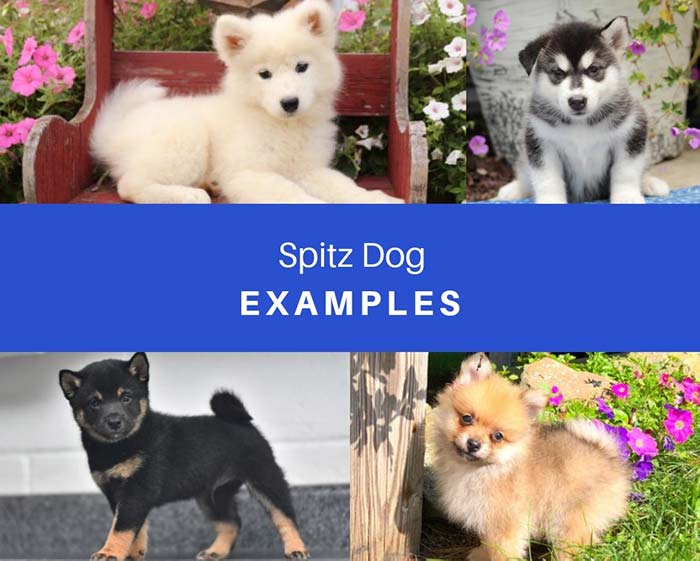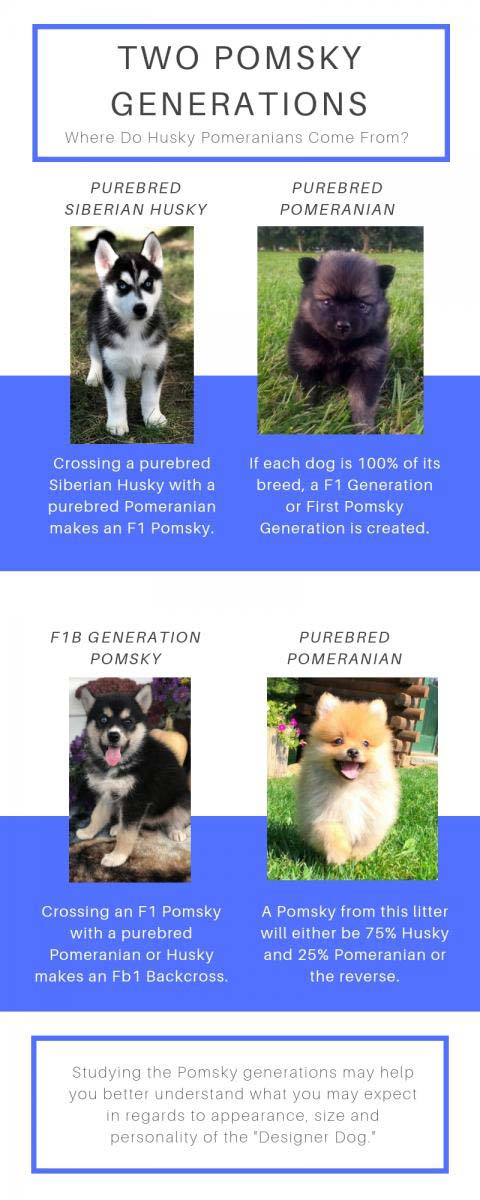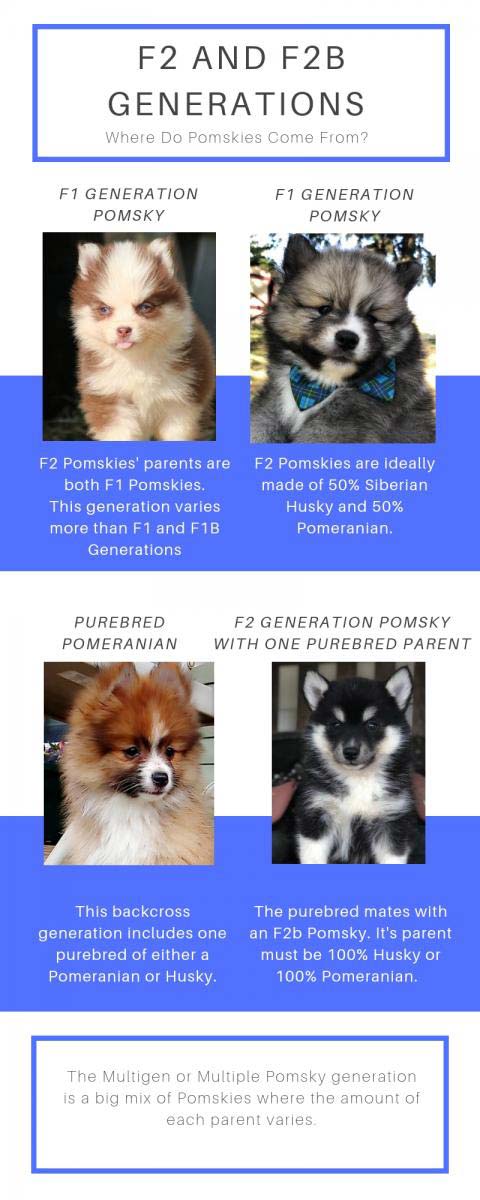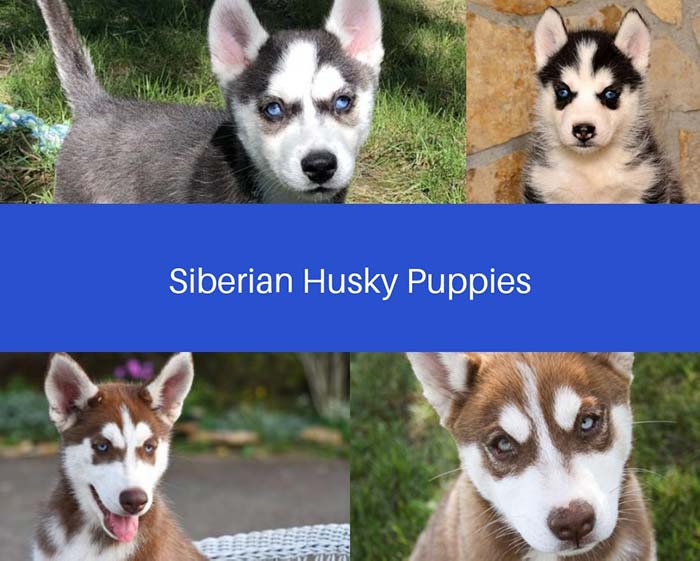Pomskies, Huskies, and Pomeranians aren’t so different—except that the first wouldn’t exist if it weren’t for the Internet sensation, Buzzfeed.
Each of these dogs is part of the Spitz family. The word “Spitz” doesn’t refer to a breed of dog. Rather, it refers to a category of dogs that have distinct characteristics: small, pointed ears with fur, long, thick double coats, almond-shaped eyes, a wolf-like resemblance, and a fluffy tail that often curls over the back or droops.
All Spitzes have fur in between the pads of their feet to keep them warm when they’re working as well as strong jaws and a wedge-shaped head. In fact, that’s where the name “Spitz” is derived. It means “pointed” in German. The long fox-like faces help keep the air warm as it moves through the nasal passages.
Through selective breeding, Spitz-type dogs have been used to hunt, herd, and pull sleds before becoming lapdogs with smiling faces.
Now they’re being crossed to create a designer dog that’s become a phenom: the Pomsky.
Pomeranian Huskies Are Tough to Spot
Many confuse Pomskies with other members of the Spitz group including Mini Huskies, Finnish Lapphunds, and Alaskan Klee Kais. With the designer dogs’ history, it’s easy to see why. These dogs all sort of look like a Pomsky.
 That’s because Spitz-type puppies have a resemblance to mini Husky-looking dogs.
That’s because Spitz-type puppies have a resemblance to mini Husky-looking dogs.
The Spitz category lumps many dogs together from the Arctic region and Siberia. These cold-weather dogs have retained their wolf-like physical characteristics as well as character traits like independence and suspiciousness. These breeds tend to be loyal and good-natured. Most Spitz are generally relatively easy to train, though they can be stubborn.
Out of the Spitz family, one of the most popular first-generation crossbreeds continues to rise in popularity: the Pomsky, a mix between a purebred Siberian Husky and a purebred Pomeranian.
This hybrid breed has been accepted into the Designer Breed Registry as well as the Dog Registry of America (DRA), the International Pomsky Association (IPA), and the Pomsky Club of America (PCA).
Pomskies, Pomeranian Huskies, Husky Pomeranians, or “Huskeranian” as they’re often called, aren’t 15-25 pound mutts. Mutts don’t have a known ancestry. Pomskies do. And it’s legendary.
Pomskies: The Real Story Behind These Designer Dogs
Although it’s been estimated that there are between 50 and 70 different types of Spitz today, one of the most popular is a “designer,” “crossbreed” or “hybrid mix”: the Pomsky which came into existence in 2012.
The Pomsky comes from two Arctic dog breeds: the 4.2 to 7.7-pound Pomeranian, whose forerunner was the German Spitz, and the 35 to 60-pound Siberian Husky.
The Pomeranian is a small, friendly, and intelligent breed that often barks in new situations. The Siberian Husky is a robust, strong working dog used to pull sleds. Together  they create the Pomsky, an adorable ball of fur.
they create the Pomsky, an adorable ball of fur.
According to Internet legend, the Pomsky was first introduced to the world when a woman posted a question online about whether her family should adopt a Pomeranian/Siberian Husky mix from a shelter. The owner was wondering about the health of the dog. The vet at the clinic dismissed that the two could be bred.
Time passed, and no one really thought about the hybrid.
By 2011, Buzzfeed Senior Editor Peggy Wang was doing her job: sharing cute stuff on the Internet. She knew the formula for making popular articles at Buzzfeed, but she needed to figure out a way to show cute, intriguing baby animals on the Internet.
She wrote an article entitled: Pomskies: The Pomeranian + Siberian Husky Mix: Cutest Designer Dog Breed Ever? Also, a Pomsky is a much better and more respectable name than a Labradoodle.
The problem with her adorable article is that Pomskies didn’t exist, at least not in a photograph-able format.

She needed to find a dog with a double thick coat, in a variety of colors like a Pomeranian and a Husky. It needed to be a small to mid-sized dog that may grow to around 20-25 pounds. The goal was to create a Husky-looking ball of fluff—but in a laptop version—that stood around 10-15 inches.
Since she didn’t have a photo of the Pomsky, (because it didn’t exist) she used pictures of small, fluffy Spitz-type dogs that weren’t Pomeranian Husky mixes at all.
Photos of fake Pomskies were taken from Buzzfeed and placed on Reddit, including an adorable photo of Tequila the Finnish Lapphund, taken by photographer Tommie Ohson.
Despite the photographer’s insistence that Tequila in the Buzzfeed article was his brother’s Finnish Lapphund and not a mythological Pomsky or Huskeranian, the photo of the cute little fluffy dog still grew in popularity. Peggy Wang’s post received more than 100,000 views.
Since no one really heard of a Pomsky before, no one suspected otherwise. After that post, many puppies that were cute, fuzzy, and small were called a Pomsky.
Once the Pomsky reached popularity on the Internet, breeders used purebred dogs to make it a reality, namely an amateur dog breeder named Tressa Peterson of Apex Pomskies. She and her friend Joline Phillips began researching their first breeding stock by getting a male Pomeranian and a female Siberian Husky. On March 5, 2012, the first official American litter of Pomsky puppies was born between a purebred female Siberian Husky and a purebred male Pomeranian. But the reality of creating a Pomsky litter isn’t as simple as posting cute photos to the Internet.
How Are Baby Pomskies Created?
Typically, a female purebred Siberian Husky is artificially inseminated by a purebred Pomeranian male. Semen is collected from the male and may be inserted into the female immediately or it can be chilled or frozen until the female goes into heat up until four days before ovulation begins. Forty-eight hours later the process is repeated. Many females are artificially inseminated through transcervical or endoscopic placement. AI is done because of the size difference of the two breeds and would be even more difficult to use a Pomeranian female because she wouldn’t be large enough to carry and give birth to puppies that large without risking her health.
Due to the size difference between the Siberian Husky and the Pomeranian, f1 generation Pomskies are created by artificially inseminating the female Husky. This is typically carried out by practicing veterinarians and experienced inseminators.
Artificial insemination has been used in the cattle industry for years and recently moved to dog breeders. There are several pros: artificial insemination helps decrease stress on the parents when the stud and dam are separated, and AI can also widen the gene pool.
But there are several cons, the chief being price. There are significant costs for stud fees for AI. Typical stud fees can be up to $1,000 but AI prices vary based on the dog’s pedigree. And despite the fees, the odds of getting pregnant are around 52 percent and up depending on a variety of circumstances.
Many assume that when they purchase a cross breed it will have all the best qualities from both parents. That’s not necessarily true and genetics don’t work that way.
Although based on previous breeding the puppies behave in a good-natured and gentle way with children. They’re often very lively and are quick to learn.
Breeders can’t determine which genes express themselves in the puppies and because the hybrid is so new there isn’t much historical data to predict which aspects of the parents will be dominant and which will be recessive. This is why the dog can vary dramatically in size, colors, and markings. It takes several generations of breeding to achieve consistency in temperament, working ability, and size.
As an example, the following are Husky coat colors that are common as well as coat patterns:
- Agouti
- Black and White
- Chocolate Copper / Chocolate Red
- Medium/Dark Grey
- Orange Copper
- Pure White
- Red and White
- Red Copper
- Sable
- Saddleback
- Silver
- Wolf Grey
- Dirty-Faced Siberians
- Piebald
- Pinto
- Splashcoat
Plus, a Husky can have a mask in the following colors:
- Clover Mask (Goggles)
- Dirty Faced Siberians
- Full Mask with Bars
- Full Mask. No bars, no eyebrows.
- Full Mask. No bars.
- Open Face, No Mask
The following Pomeranian colors for their long, fur coat is also common as are their markings:
- Beaver
- Black
- Blue
- Brindle
- Chocolate
- Cream
- Lavender
- Orange
- Red
- Sable
- White
- Wolf Sable
- Brindle
- Merle
- Parti
- Tan Point Black mask
There is not enough data at present to predict how the qualities above will express themselves through genetics nor is there enough data to forecast health concerns or behavioral problems because these dogs can inherit anything from the parent breeds. The result is often unpredictable. Just by looking at colors, it's tough to make an educated guess on how the pup will look.
The Pomsky puppy won’t have a standard look but it won’t be a teacup either, because dogs that fall under 5 pounds qualify as teacups. One pup can look different from another even if they are from the same litter. Some look more like Siberian Huskies; others look like Pomeranians. It all comes down to dominant genes.
Hybrid dogs, like Pomskies, may have genetic problems but it’s typically lower than purebred dogs because the gene pool is mixed. Purebred breeders who breed Huskies to Pomeranians create a first-generation hybrid where they don’t know the exact size, look, or temperament of the dog. These breeders believe in hybrid vigor and the heterosis effect.
Since there is no standard look, it’s so easy to mistake Pomskies for miniature wolves, Miniature Huskies, Finnish Lapphunds, Alaskan Klee Klais, or other fuzzy Spitz-type puppies.
Siberian Huskies and Mini Huskies Aren’t Pomsky Huskies
A Mini Husky is sometimes confused with a Pomsky.
Bree Normandin began breeding Mini Huskies in the 90s by selectively breeding smaller Huskies. This means Mini Huskies and standard-sized Huskies have the same pedigree.

Minis have the same pedigree as the Siberian Huskies, however, Minis have been selectively bred for their size. Still, they retain the signature double coat, the same colors including white, black and white, grey and white, brown and white, red and white, cream and white, sable and white (sometimes called ‘black-nosed reds’), or silver and white or Agouti (meaning wild coloring or wolf-like). They may come in three greys: wolf grey, silver, or medium dark grey. These dogs may also be copper or black but those aren’t standard colors recognized by the AKC. Although Mini Huskies may have saddleback markings, be piebald, pinto, dirty-faces, or black points just like a Pomsky, the dogs are not the same.
Teacup huskies don’t exist as they are bred from medium-sized dogs; most teacup varieties are bred down from miniature-sized dogs and weigh less than 5 pounds.
American Klee Kais Aren't The Same as a Husky Pomeranian Mix
A Pomsky is also not an Alaskan Klee Kai, as is commonly mistaken.
The Alaskan Klee Kai companion-sized dog that resembles an Alaskan Husky. An Alaskan Klee Kai was developed by Linda Spurlin in Wasilla, Alaska from the 70s to the 80s by blending the Alaskan Husky, Siberian Husky, Schipperke, and American Eskimo dog to produce a companion-sized version of the Alaskan Husky without leading to dwarfism.
Named after the Eskimo word for “little dog,” the Alaskan Klee Kai is not an AKC registered breed, but it is a rather small hunting dog. It’s also not a Pomsky.
Finally, although a lot of mystery surrounds its beginnings, it’s easy to see why the Pomsky has become a popular designer dog. The hybrid combines a majestic Siberian Husky with a compact Pomeranian. The result is a gorgeous new companion that’s a fun, energetic ball of fur.

